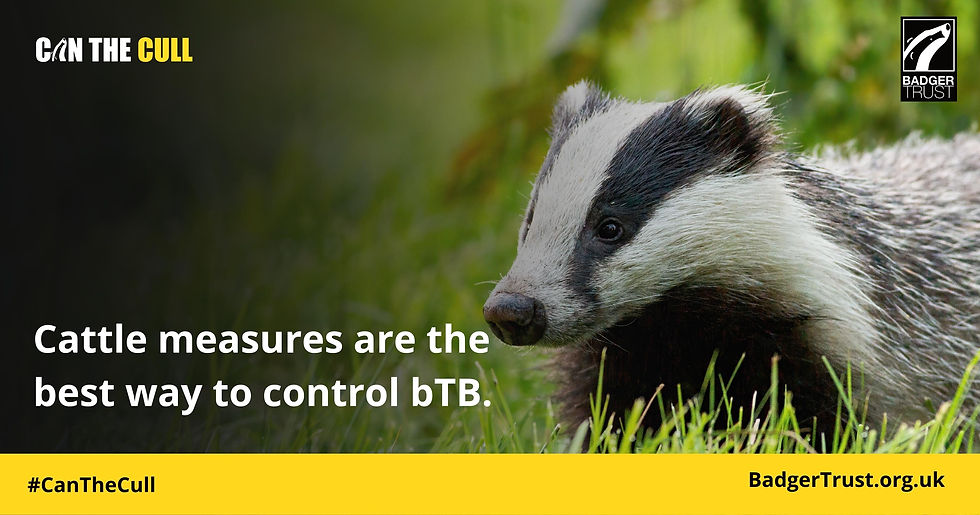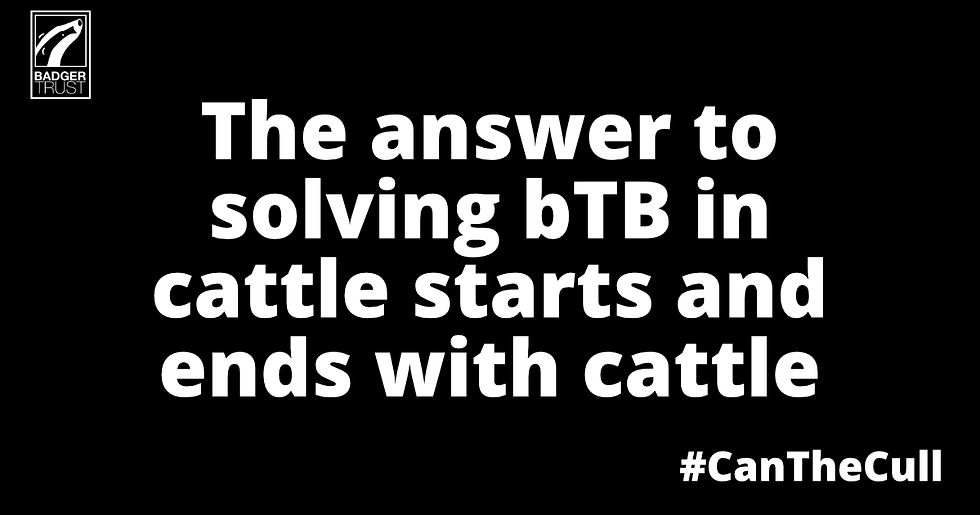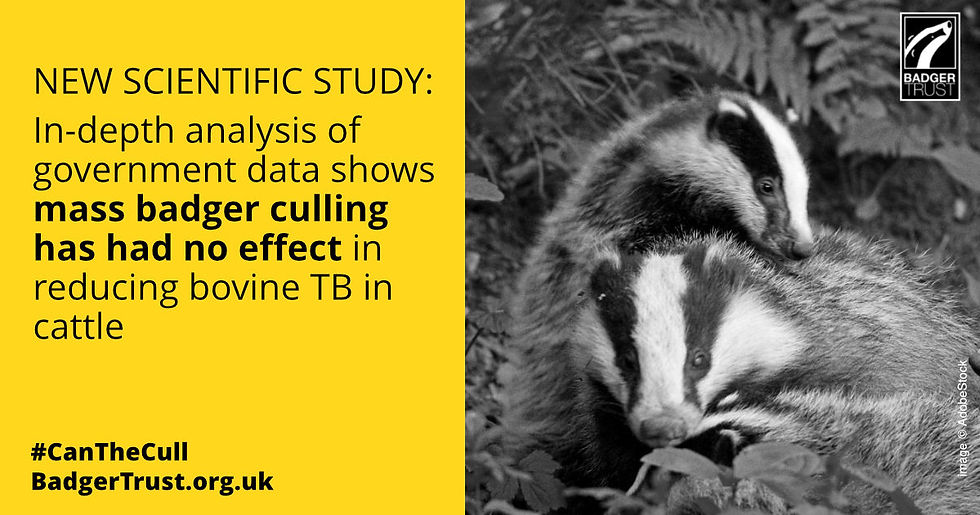It’s Time Defra Faced the Facts: Myth Busting the Badger Cull
- Badger Trust Staff Team

- Sep 6, 2022
- 10 min read
A decade on, here’s all you need to know about the science of badger culling and why it does not work.
2022 sadly marks the tenth year of the government-endorsed badger cull. The scale of the cull against this protected native species is shocking and intensifying.
However, despite growing public and scientific opposition, Defra is still focused on the ineffective and unproven ‘sledgehammer’ of badger culling to end bovine TB in English cattle herds.
So what has the science shown since the culling began, and what about those studies which Defra cites in support of their cruel campaign against wildlife? First, we take a look at the scientific evidence of the real issue: cattle-to-cattle transmission.

The issue really isn’t badgers – it’s cattle biosecurity
Bovine tuberculosis (bTB) is primarily a respiratory infection, and whilst some level of infection can remain in the environment, its main route of transmission is direct contact with an infected individual.
Cattle-to-cattle transmission has been recognised overwhelmingly as the primary driver of bTB outbreaks in cattle herds. That’s why cattle biosecurity is vital in fighting this disease.
What is cattle biosecurity?
There are many forms of biosecurity that can be employed to control disease within animal populations. For the control of bTB, enhanced cattle testing and reporting, controls on cattle movement, safe management of slurry, and fencing to prevent wildlife from entering farm buildings can all be employed to reduce rates of infection.
Whilst there is not currently an approved cattle vaccine available [1], cattle testing is the best line of defence. Unfortunately for farmers, however, Defra’s cattle tests are unreliable. It has been known since at least 2013 [2] that the sensitivity (positive individuals identified) can be as low as 49% at standard test interpretation. This means that between one in two and one in five (50% - 20%) of infected animals could be missed each time a herd is tested.
Furthermore, reporting of positive test results is routinely ill-managed. Results from the DEFRA Farm Practices Survey (2019) [3] showed that of the participating farmers who had bought cattle in the last 12 months;
18% of purchasing farms did not find out the date of the pre-movement test
26% of purchasing farms did not find out the date of the source farm’s last routine test
33% of purchasing farms did not find out the source farm’s bTB risk area
23% of purchasing farms did not find out the testing frequency of the source farm
If test results are not properly recorded and shared, then there is little reason to test at all. It is therefore clear that the current testing system is broken. Other disease control strategies that should be employed by farms include fencing off livestock and feeds from wildlife, and increasing hygiene and sanitation practices.
Yet, farm biosecurity is costly to the farmer and shifts the focus of blame from wildlife to the agricultural sector. Indeed, the DEFRA 2019 Farming Practices Survey revealed that:
Only 24% of farms have installed sheeted gates (to prevent wildlife from accessing buildings)
52% of farms have raised feed troughs and mineral licks (to prevent wildlife from using them)
29% of farms spread slurry on grazing land, a small percentage of which is from other farms
Only 33% of farms that spread slurry wait six months before spreading
Only 36% of farms double fence between livestock and other herds
Only 37% of farms carry out disinfectant regimes (footbaths, wheel sprays, etc.)
Only 15% of farms fence off badger setts and latrines (despite the culling of hundreds of thousands of badgers)
Only 17% of farms ‘badger proof’ buildings
Worse, of the above measures, between 20% and 33% of farmers have stated that they would never implement them.
Unless these measures are made mandatory and unless compensation is linked directly to compliance with them, bTB will continue to spread.

What is the history of bTB in Britain?
Interestingly, we only need to look at the history of bTB’s emergence in Britain to see that cattle biosecurity was the primary driver of the epidemic.
Bovine TB had also almost been eradicated through enhanced cattle biosecurity, that is until the badger scapegoat came along.
The following timeline was published in a global review of bTB cattle-to-cattle transmission [4]:
The 1800s:
Infected bTB cattle dispersed to former British colonies. In the absence of effective control programmes, further cattle-cattle transmission occurred including transmission to other imported or native breeds and to wildlife.
The Mid-1900s:
The introduction of targeted, exclusively cattle-based control measures dramatically reduced the prevalence of bovine TB in cattle in the mid-1900s in many countries.
The 1960s:
Bovine TB was almost eliminated from Britain through rigorous testing of cattle herds and strict quarantine.
2001:
During the British foot and mouth disease (FMD) outbreak, cattle movements and bovine TB testing were suspended.
Bovine TB was detected in herds in Northern England that had restocked post-FMD. Molecular typing of confirmed cases supported the conclusion that, in most herds, infection had been introduced by the unwitting purchase of animals with undisclosed infection from bTB hotspot areas.
Identification of tuberculin skin test reactors in home-bred and purchased animals suggested further within-herd cattle-to-cattle transmission.
By 2002:
The enhancement of solely cattle-based measures contributed to a significant reduction in bovine TB prevalence in Northern Ireland.
2007:
Results from the Randomised Badger Culling Trial led Professor John Bourne and the Independent Scientific Group to conclude that:
“…weaknesses in cattle testing regimes mean that cattle themselves contribute significantly to the persistence and spread of disease in all areas where TB occurs… Scientific findings indicate that the rising incidence of disease can be reversed and geographical spread contained by the rigid application of cattle-based measures alone.”
So why cull badgers?
It all started with one unfortunate victim in April 1971 when a dead badger tested positive for bTB. This was the turning point for national bTB rhetoric, as finally there was a subject to blame that was, at the time, free from government control. The first dead badger was then followed by another ailing individual who was shot dead and found positive for bTB infection. Both these badgers were living in bTB hotspots.
Never before had badgers been so strongly associated with bTB, despite bTB being prevalent in Britain since the 1800s. It was highly likely that these badgers had contracted the disease from cattle, yet their deaths offered a convenient scapegoat for the government and the agricultural sector. Even then, epidemiological evidence was not in support of badger-directed disease control measures. Zoologist J F D Frazer [5], of the Nature Conservancy Council, on speaking of the discovery of bTB-infected badgers, noted his scepticism at the time:
“The evidence for the badger as a source of infection is somewhat flyblown. If anything, badgers are more likely to have been infected from the cattle in the first place.
There is no evidence of badgers breathing in the calves’ faces or spitting on the grass. Nor, as far as we know, has there been any check on the farmer, his family and his cowman — man being a major host of bovine tuberculosis.”
Regrettably, in the face of mounting pressure from the National Farmers Union, the badger scapegoat proved too difficult for the government to resist and in 2013 intensive badger cull licences were issued.
Now, with 61 cull zones across England, badgers have undergone a politicised, unscientific, and cruel campaign of eradication.
Science shows badger culling doesn’t work
A decade on from the first intensive cull licences, and at the cost of over 176,000 dead badgers, the data is in and it confirms what the scientific community feared: Badger culling does not work.
Only this year, independent research [6] found badger culling is an ineffective method for controlling bTB, findings which were published in the peer-reviewed journal Vet Record by ecologist Tom Langton and veterinarians Mark Jones and Iain McGill.

The study utilised bTB records published by Defra. The researchers found no statistical basis in support of badger culling for reducing bTB in cattle. Whilst the study did include the positive news that bTB was being effectively controlled through enhanced biosecurity measures for cattle herds, all results of the study were dismissed by Defra which refused to engage with the authors about their findings.
Not only has Defra ignored results which clearly support cattle biosecurity as the most worthy investment to control bTB in cattle, but Defra also sought to discredit the scientists by labelling them as ‘anti-cull activists' and claiming their method was designed to “fit a clear campaign agenda”.
Yet, Defra’s official rebuttal of the research by Langton, Jones and McGill was later retracted as their own figures had been incorrectly calculated. Defra’s revised calculations [7] revealed figures in apparent agreement with the findings of the independent research.
And still, Defra continues its sneak tactic of culling well beyond 2025, quoting dubious and outdated research.
Government’s 'cherry picking' of science
The most frequent research cited by the British government in support of the cull was published by Downs et al in 2019 [8]. Unlike the Langton et al (2022) paper which analysed results from all cull zones within the entire cull period, Downs et al (2019) claimed to find a decline in bTB in three pilot cull areas from 2013 to 2017. This is despite the authors themselves highlighting that they were unable to isolate other influences for this decline, such as improved veterinary advice or better biosecurity on farms.
A repeat study [9] found no reliable downward trend in bTB in cattle related to the cull, and in Gloucestershire – one of the pilot areas – there was a 130% increase in bTB in cattle in the 12 months after the Downs study ended.
The government’s continual reference to ambiguous findings from outdated research furthers the frustration felt by the scientific community and animal welfare organisations alike.
What are the real effects of culling?
The true effects of badger culling are much more damaging than might otherwise be expected. Not only are the cull methods inhumane and cause significant welfare implications for badgers, but the culling of a highly social mammal causes disruption to familial groups through the removal of clan members. Furthermore, the removal of badgers, who are ecosystem engineers [10], negatively impacts other species who rely on badger foraging and tunnel digging behaviour to maintain soil health and provide shelter.
From a disease transmission perspective, badger culling is bad news too and early studies even linked badger culling with an increased risk of bTB in cattle [11]. Badgers have been found to range further in cull areas than areas without culling, despite dispersal resulting in lower rates of reproduction [12]. The change in movement patterns is known as the perturbation effect and is often cited as a cause for concern as disease can be spread further when an animal's range increases. This information was available to the government before they issued the first intensive cull licences.
In a 2011 paper, researchers concluded (of the proposed cull) that:
“...the social disruption caused by culling may not only increase direct contact and thus disease transmission between surviving badgers, but may also increase social stress within the surviving population, causing immunosuppression and enhancing the expression of disease.” [13]
Overall, the biggest take-home message of ten years of culling is that it simply does not work. Bovine TB is effectively managed by England’s own neighbouring countries. In Wales, for example, bTB is controlled through enforcement of biosecurity and leaving badgers alone, a real-life example of how to manage disease in cattle successfully.
Badger culling has become England’s fool’s errand. Its track record leaves nothing but a failed policy, and distrust in a government that ignores science and hides facts, all in the wake of uncontrolled disease in cattle and over 176,000 dead badgers.
Further Information
[1] Government Press Release: ‘Field trials for leading cattle vaccine and skin test for bTB’ https://www.gov.uk/government/news/field-trials-for-leading-cattle-vaccine-and-skin-test-for-btb
[2] Godfray, H.C.J., Donnelly, C.A., Kao, R.R., Macdonald, D.W., McDonald, R.A., Petrokofsky, G., Wood, J.L., Woodroffe, R., Young, D.B. and McLean, A.R., 2013. A restatement of the natural science evidence base relevant to the control of bovine tuberculosis in Great Britain. Proceedings of the Royal Society B: Biological Sciences, 280(1768), p.20131634. https://royalsocietypublishing.org/doi/10.1098/rspb.2013.1634
[3] Defra Farm Practices Survey. https://assets.publishing.service.gov.uk/government/uploads/system/uploads/attachment_data/file/870305/fps-general-statsnotice-05mar20.pdf
[4] Skuce, R.A., Allen, A.R., McDowell, S.W. and Branch, B., 2011. Bovine tuberculosis (TB): a review of cattle-to-cattle transmission, risk factors and susceptibility. Bacteriology Branch Veterinary Sciences Division Agrifood and Biosciences Institute, 1, pp.115-167. https://seapi.rs.gov.br/upload/arquivos/201711/29165353-afbi-literature-review-tb-review-cattle-to-cattle-transmission-1.pdf
[5] J. F. D. Frazer, ‘In Confidence: Badgers and Bovine TB Investigation’, 8 September 1971, NA FT 41/88.
[6] Langton, T.E., Jones, M.W. and McGill, I., 2022. Analysis of the impact of badger culling on bovine tuberculosis in cattle in the high‐risk area of England, 2009–2020. Veterinary Record, 190(6), p.e1384. https://bvajournals.onlinelibrary.wiley.com/doi/pdfdirect/10.1002/vetr.1384
[7] Defra’s revised calculations https://bvajournals.onlinelibrary.wiley.com/doi/epdf/10.1002/vetr.1822
[8] Downs, S.H., Prosser, A., Ashton, A., Ashfield, S., Brunton, L.A., Brouwer, A., Upton, P., Robertson, A., Donnelly, C.A. and Parry, J.E., 2019. Assessing effects from four years of industry-led badger culling in England on the incidence of bovine tuberculosis in cattle, 2013–2017. Scientific reports, 9(1), pp.1-14. https://www.nature.com/articles/s41598-019-49957-6
[9] McGill, I. and Jones, M., 2019. Cattle infectivity is driving the bTB epidemic. Veterinary Record, 185(22), pp.699-700. https://bvajournals.onlinelibrary.wiley.com/doi/abs/10.1136/vr.l6845
[10] Kurek, P., Piechnik, Ł., Wiatrowska, B., Ważna, A., Nowakowski, K., Pardavila, X., Cichocki, J. and Seget, B., 2022. Badger Meles meles as Ecosystem Engineer and Its Legal Status in Europe. Animals, 12(7), p.898. https://www.researchgate.net/publication/359657585_Badger_Meles_meles_as_Ecosystem_Engineer_and_Its_Legal_Status_in_Europe
[11] Vial, F. and Donnelly, C.A., 2012. Localized reactive badger culling increases risk of bovine tuberculosis in nearby cattle herds. Biology Letters, 8(1), pp.50-53. https://royalsocietypublishing.org/doi/abs/10.1098/rsbl.2011.0554
[12] Tuyttens, F.A.M., Macdonald, D.W., Rogers, L.M., Cheeseman, C.L. and Roddam, A.W., 2000. Comparative study on the consequences of culling badgers (Meles meles) on biometrics, population dynamics and movement. Journal of Animal Ecology, 69(4), pp.567-580. https://besjournals.onlinelibrary.wiley.com/doi/pdf/10.1046/j.1365-2656.2000.00419.x
[13] Riordan, P., Delahay, R.J., Cheeseman, C., Johnson, P.J. and Macdonald, D.W., 2011. Culling-induced changes in badger (Meles meles) behaviour, social organisation and the epidemiology of bovine tuberculosis. PloS one, 6(12), p.e28904. https://journals.plos.org/plosone/article?id=10.1371/journal.pone.0028904

How YOU can HELP BADGERS NOW
There are many ways you can help protect badgers and oppose the government's failing, unscientific and cruel badger cull:
Request your free Badger Cull Action Pack now
The pack contains:
Take Action leaflet with facts on the cull and how you can take action
Postcard to send to your MP (and one to pass to a friend) to call for an end to the cull
Bookmark to thank you for protecting badgers
Write to your MP about the reality of the badger cull
Need help? Send our dedicated cull postcard, or read our online guide ‘How to Write to your MP’.
Donate to protect badgers
As a registered charity, Badger Trust relies on donations from people like you to continue our work. So please donate if you can – every pound counts. And if you can make a regular monthly donation, you’ll help us to plan our campaign work more effectively.
100% of your donation supports our work for badgers with funds directed to where the need is greatest.
Join our clan!
Become part of our badger family by joining us as a clan supporter. You’ll be among the first to hear about our campaigns and make a difference to badgers every day of the year.
Get active locally
You can help badgers near you right now by getting involved with your local badger group.
Help us raise awareness
Tell your friends and family, gift a postcard to send, follow us on social media and share the latest badger news.
Keep up-to-date with the latest campaign news
Do you get our regular e-newsletter? Sign up now.
Find out more about the badger cull
Discover even more cull facts, solutions to the bTB problem, what we do, and what you can do to take action for badgers.



